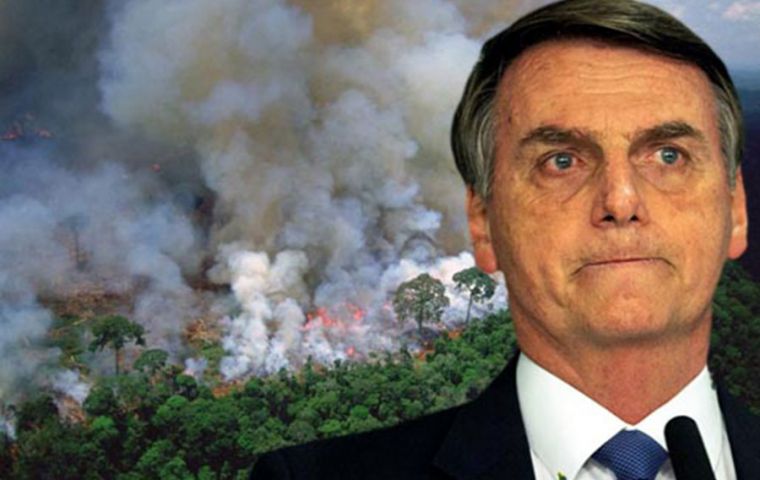MercoPress. South Atlantic News Agency
Deforestation of Amazonia takes turn for the worse despite Brazilian President's promises
 Bolsonaro is now “trying to reward those who practice illegal deforestation and land theft,” said Greenpeace's Mazzetti.
Bolsonaro is now “trying to reward those who practice illegal deforestation and land theft,” said Greenpeace's Mazzetti. Brazil's National Institute Institute for Space Research (Inpe) has released over this past weekend updated data regarding the deforestation of Amazonia between August 2020 and July 2021.
According to the most recent figures, a loss of 8,712 square kilometers has been detected, making it the second highest yearly deforestation ever measured by the Determin alert system, which is based on hi-fi resolution satellite data.
This technology is capable discriminating polygons larger than 6.25 hectares and it has shown clear cutting, deforestation with vegetation and areas of illegal mining, in addition to the degradation process in different intensities, traces of fire and selective cuts. The system is key in the Strategy for the Brazilian Biomass Environmental Monitoring Program.
“After the process of dismantling environmental protection laws, the government of Jair Bolsonaro and the Brazilian Congress are now trying to reward those who practice illegal deforestation and land theft,” said Greenpeace Brazil spokesperson Cristiane Mazzetti. “This will worsen the current climate and biodiversity crisis,” she added.
According to the international environmental NGO, last Tuesday the Brazilian House of Deputies approved Bill PL2633 “to legitimize the grabbing of public lands,” which Greenpeace regards “directly related to the deforestation of a third of all the surface that the Brazilian Amazon loses.” The Bill is now up to the Senate.
“Despite (Jair) Bolsonaro's recent promises to tackle illegal deforestation, and while he hopes to negotiate trade deals with the European Union, the United States, the United Kingdom, and Canada, he and his allies are pushing forward a set of projects for law that would allow further deforestation and undermine the rights of indigenous peoples over their territories,” Mazzetti insisted in reference to the Brazilian President's promises during the last Climate Leaders Summit when he pledged to increase the volume of operations against deforestation in the Amazon in the short term.
Instead, Bolsonaro's government continues to weaken the capacity of environmental agencies and “for the third year in a row the Armed Forces are once again used to investigate environmental crimes, a strategy that has proven to be ineffective,” Mazzetti pointed out.
She also warned that “if the Brazilian Senate passes the law on land grabbers, the collapse of the Amazon will precipitate, destroying parts of the tropical forest that are key to preventing the worst scenarios of climate and biodiversity emergencies.”
Greenpeace Brazil flies regularly over the Amazon to monitor deforestation and forest fires on alerts from the Deter (Real Time Deforestation Detection System) and Prodes (Brazilian Amazon Satellite Monitoring Project) system.
The organization has also scanned hot spots called out by Inpe in the states of Amazonas, Rondônia, Mato Grosso and Pará.
During a flight in the last week of July, Greenpeace Brazil sighted fires in several areas affected by deforestation, including one area 2,716 hectares in size, which the NGO explained was tantamount to 3,888 football fields.
A research led by the University of Leeds, England, has warned that Amazon rainforests could run a risk of extreme drought much greater than previously thought. The study warns that huge areas of the eastern part of the Amazon face serious desiccation by the end of the century if measures are not taken to curb carbon emissions. As a consequence, large amounts of carbon dioxide would be released from the rainforest into the atmosphere, increasing the greenhouse effect which speeds up climate change.
The dry season of the Amazon River would further threaten the viability of large parts of the rainforest, as trees are already under water stress and there is an increased risk of forest fires.
The anticipated droughts could also have far-reaching consequences for the Amazon's water cycle, biodiversity, and the population living in the region. The results, published in the journal Environmental Research Letters, foresee reductions in rainfall comparable to those recorded during the major droughts of 2005 and 2010, which caused widespread tree mortality and had major impacts on Amazonian communities.




Top Comments
Disclaimer & comment rulesCommenting for this story is now closed.
If you have a Facebook account, become a fan and comment on our Facebook Page!